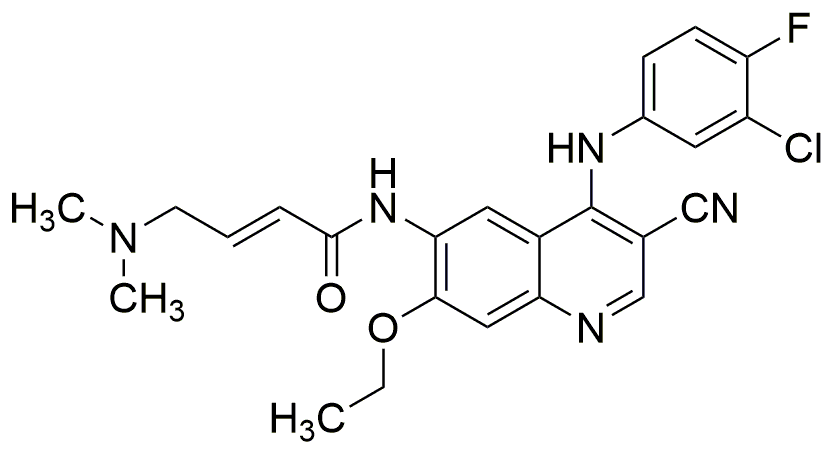Pelitinib is widely utilized in research focused on:
- Cancer Treatment: Pelitinib is primarily studied for its potential in treating various types of cancer, particularly non-small cell lung cancer (NSCLC). Its targeted action on specific cancer cell pathways makes it a promising candidate for personalized medicine.
- Drug Development: Researchers are exploring Pelitinib as a lead compound for developing new anti-cancer drugs. Its unique structure allows for modifications that can enhance efficacy and reduce side effects compared to traditional chemotherapy agents.
- Combination Therapies: Pelitinib is being investigated in combination with other therapies to improve treatment outcomes. This approach can help overcome resistance mechanisms that often limit the effectiveness of single-agent treatments.
- Biomarker Research: The use of Pelitinib in clinical studies is aiding the identification of biomarkers that predict patient responses to treatment, which is crucial for optimizing therapy and improving patient outcomes.
- Pharmacokinetic Studies: Pelitinib's pharmacokinetic profile is being analyzed to understand its absorption, distribution, metabolism, and excretion in the body, providing valuable information for dosage optimization and safety assessments.
Informations générales
Propriétés
Sécurité et réglementation
Applications
Pelitinib is widely utilized in research focused on:
- Cancer Treatment: Pelitinib is primarily studied for its potential in treating various types of cancer, particularly non-small cell lung cancer (NSCLC). Its targeted action on specific cancer cell pathways makes it a promising candidate for personalized medicine.
- Drug Development: Researchers are exploring Pelitinib as a lead compound for developing new anti-cancer drugs. Its unique structure allows for modifications that can enhance efficacy and reduce side effects compared to traditional chemotherapy agents.
- Combination Therapies: Pelitinib is being investigated in combination with other therapies to improve treatment outcomes. This approach can help overcome resistance mechanisms that often limit the effectiveness of single-agent treatments.
- Biomarker Research: The use of Pelitinib in clinical studies is aiding the identification of biomarkers that predict patient responses to treatment, which is crucial for optimizing therapy and improving patient outcomes.
- Pharmacokinetic Studies: Pelitinib's pharmacokinetic profile is being analyzed to understand its absorption, distribution, metabolism, and excretion in the body, providing valuable information for dosage optimization and safety assessments.
Documents
Fiches de données de sécurité (FDS)
La FDS fournit des informations de sécurité complètes sur la manipulation, le stockage et l’élimination du produit.
Spécifications du produit (PS)
Le PS fournit une description complète des propriétés du produit, notamment sa composition chimique, son état physique, sa pureté et les exigences de stockage. Il détaille également les plages de qualité acceptables et les applications prévues du produit.
Certificats d'analyse (COA)
Recherchez des certificats d'analyse (COA) en saisissant le numéro de lot du produit. Les numéros de lot et de lot se trouvent sur l'étiquette d'un produit, après les mots « Lot » ou « Lot de fabrication ».
Numéro de catalogue
Numéro de lot/série
Certificats d'origine (COO)
Ce certificat d'exploitation confirme le pays dans lequel le produit a été fabriqué, et détaille également les matériaux et composants utilisés et s'il est issu de sources naturelles, synthétiques ou autres sources spécifiques. Ce certificat peut être requis pour les douanes, le commerce et la conformité réglementaire.
Numéro de catalogue
Numéro de lot/série
Fiches de données de sécurité (FDS)
La FDS fournit des informations de sécurité complètes sur la manipulation, le stockage et l’élimination du produit.
DownloadSpécifications du produit (PS)
Le PS fournit une description complète des propriétés du produit, notamment sa composition chimique, son état physique, sa pureté et les exigences de stockage. Il détaille également les plages de qualité acceptables et les applications prévues du produit.
DownloadCertificats d'analyse (COA)
Recherchez des certificats d'analyse (COA) en saisissant le numéro de lot du produit. Les numéros de lot et de lot se trouvent sur l'étiquette d'un produit, après les mots « Lot » ou « Lot de fabrication ».
Numéro de catalogue
Numéro de lot/série
Certificats d'origine (COO)
Ce certificat d'exploitation confirme le pays dans lequel le produit a été fabriqué, et détaille également les matériaux et composants utilisés et s'il est issu de sources naturelles, synthétiques ou autres sources spécifiques. Ce certificat peut être requis pour les douanes, le commerce et la conformité réglementaire.


